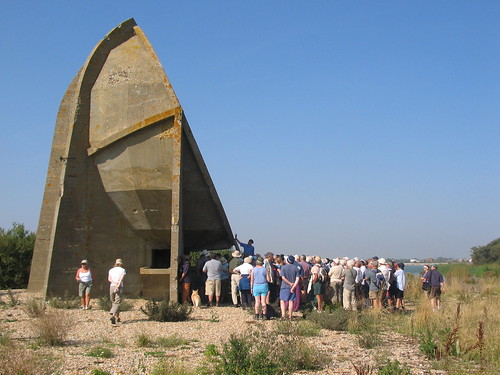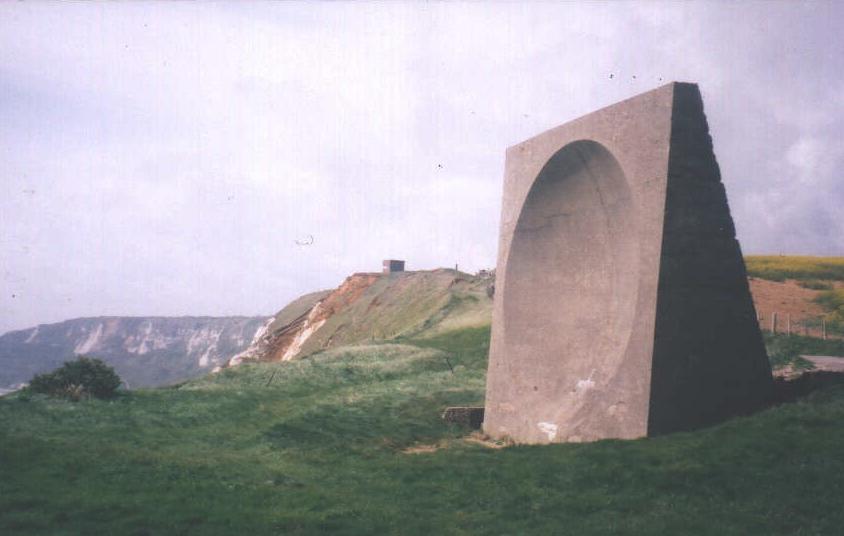Crafty Shirley’s Photo Gallery – Sound Mirrors By The Sea. Within a short walk of where we live is Lade Pit. At the back of these lakes are the three Listening Devices built in the 1920s and 30s as part of a national early warning system against enemy aircraft.
Author: Andrew Grantham
The Devil of Denge Marsh
I think it must have been a radio programme, or something like that… the picture seems to show an aloe vera plant attacking the 30 foot mirror at Denge.
The Scarifyers return in their second full-length adventure…
A melting minister… a scientific project gripped by madness…
a remote village on the Kent coast where the locals have some strange habits indeed. It’s all just the ticket for top-secret government department, MI-13.Lionheart (Nicholas Courtney) and Dunning (Terry Molloy) are back, to do battle with the Women’s Institute, an old adversary and an inter-dimensional being from the dawn of time – THE DEVIL OF DENGE MARSH.
Source: Cosmic Hobo
Denge sound mirrors feature in prize-winning graphic story
Julian Hanshaw won the 2008 Observer/Cape Graphic Short Story Prize with Sand Dunes and Sonic Booms, described by the Observer as a “haunting, evocative and beautifully drawn story”. It is set on the south coast, and at the Denge mirrors in particular.
We loved Hanshaw’s sense of time and place – an effect he achieved partly through a series of sepia frames illustrating the south coast. Hanshaw is an animator by training, and moved to Winchelsea, East Sussex from London three years ago. Since then he has become ‘mildly obsessed’ with the area, particularly the spectral and strange Dungeness. The idea for ‘Sand Dunes and Sonic Booms’ came after a visit to one of the south coast’s sound mirrors – primitive devices designed to detect and track military aircraft before the First World War (though the ones in Kent date from the 1930s).
Source: The Observer 2009-11-09
You can read the story here: Sand Dunes & Sonic Booms.
Parabolic sound mirrors to reflect and focus sound
The Whipple Museum of the History of Science in Cambridge has a webpage about some parabolic sound mirrors to reflect and focus sound.
This apparatus consists of a pair of brass parabolic reflectors mounted on wooden stands. One of the reflectors has a bracket with a hook for hanging a pocket watch. The demonstrator would use this apparatus to show how the sound of a ticking watch may be heard at a considerable distance having first been made into a beam, projected over a distance and refocused. Very little is known about this pair of mirrors in the Whipple’s collection. It is thought that they were made in France or Germany during the second quarter of the nineteenth century.
Source: Whipple Museum of the History of Science
Holderness defences

The August 2006 issue of East Yorkshire local magazine The West In View looked at military defences in Holderness, including the Kilnsea sound mirror, and used some of my photos of the Cherry Cob Sands bombing decoy.
You can download a PDF of the magazine.
Photos from August 2008 guided walk
Dave Snowdon went on a guided walk to the sound mirrors of Lade Pit, Dungeness on 17 August 2008. There were, apparently, 261 people who attended this walk. The largest group in the 11 years Dr. Scarth has been giving these talks
.
He has some photos of the mirror and the crowds on his website.
2009 guided walks to the Denge sound mirrors
The Romney Marsh Countryside Project has announced the dates when the sound mirrors at Denge can be visited in 2009.
Due to the overwhelming popularity of last years Echoes of the Sky tours we are making a few changes this year. We will be holding a new open day on Sunday 19th July. The island will be open from 10am in the morning until 5pm. Dr Richard Scarth, an expert on these structures, will be present to answer any questions. We will have a number of staff stationed at key places to help direct people to the island. There will a member of staff on the bridge asking for a £2 donation per person to cover costs. Parking is available at Lade car park, opposite Taylor Road on Coast Drive (halfway between the Pilot Pub and Romney Sands) (TR 085 208). This will be a non-booking event, you just need to turn up on the day. The walk will be across shingle. For anymore details contact the Romney Marsh Countryside Project on 01797 367934 or email us at mail@rmcp.co.uk.
ECHOES FROM THE SKY WALKS 2009 WALKS DATES ANNOUNCED
As well as the new open day we will be holding two guided walks on Sunday 16th August and Sunday 13th September. They will be lead by ourselves and Dr Richard Scarth, the world’s expert on these structures. The walks start at 2pm and we will be meeting at the Lade car park opposite Taylor Road on Coast Drive (halfway between the Pilot Pub and Romney Sands) (TR 085 208). The walk will last approximately 2.5 hours and is over shingle. It is a non-booking event and donations are appreciated. For more information contact the RMCP on 01797 367934 or email mail@rmcp.co.uk
Source: RMCP
Obviously people should confirm details with RMCP nearer the time. The walks are well worth doing!
Air War Over East Yorkshire book
Over Christmas I read Air War Over East Yorkshire, an interesting book by Paul Bright about WWII aviation in the East Riding.
It avoids the dryness of a lot of military books, and unusually has a fair amount of data about the Luftwaffe as well as the Allied forces. It discusses the radar stations in the area, including RAF Staxton Wold, possibly the oldest active radar site and with a history as an early warning site stretching back pretty much forever.
Air War Over East Yorkshire
In most accounts of the air war over Britain in summer 1940, the events over East Yorkshire are mentioned only in passing, yet it was there, on 20 August, that the first enemy aircraft fell to the guns of a Polish fighter squadron in the RAF, less than a mile from where these words are being written. It was also where the ‘north-east town’, as Hull was identified in the news bulletins of the day, suffered its prolonged agony under the bombs of the Luftwaffe. Indeed, the very last British civilians to die as a direct result of Luftwaffe bombs in World War II were killed in Hull on 17 March 1945. As the home of much of the RAF’s night-bombing force, East Yorkshire was also frequently the scene of Luftwaffe night intruder raids. This book, based on years of in-depth research into primary sources, personal accounts and experiences, reveals many new facts and gives long-overdue recognition to the events and people who fought, lived and all too often, died, in East Yorkshire during 1939-1945.
AUTHOR NOTES:
Paul Bright, now a retired history teacher, was born in Hunmanby, then a part of East Yorkshire, and as a schoolboy witnessed at firsthand quite a few of the events described in this book. His father was an auxiliary fireman in Hunmanby who participated in the response to many of the air attacks and their aftermath. Other members of his family endured the Blitz in Hull, consequently he is able to write about the period from personal experience as well as from the perspective of the dispassionate historian. He lives in Filey.
Source: Flight Recorder Publications
Invaders Must Die by The Prodigy
On February 23 2009 The Prodigy will release an album called Invaders Must Die, which features a track of the same name for which a video was shot at Dungeness. The Denge sound mirrors feature from about 1 min 15 sec in.
‘Invaders Must Die’ is 40 minutes of having your head battered by future nostalgia, serotonin levels twisted by feel-good horrorcore and your synapses snapped by whiplash attitude. It’s the sound of The Prodigy mixing up genres, contorting the past and rewiring the future, ram-raiding through the tranquility of music’s status quo like a blot on the landscape of England’s dreaming.
Source: Invaders Must Die
So now we know. I just hope no morons get it into their heads to try vandalising the mirrors as depicted in the video.
The mirrors have been used by a variety of musicians, including Turin Brakes, Bass Communion and Blank & Jones.
(thanks to Ken Morrow for letting me know about the video)
The ice mirror cometh
It’s a bit cold outside — but not cold enough to make a sound mirror out of ice, which is what has been done in Alaska!

The mirror was created as part of the Freeze celebration of Alaska and life in the North
held in Anchorage during January 2009. It was designed by Klaus Mayer, Petra Sattler-Smith and Marisa Favretto, who were inspired to create the ice mirror by the British sound mirrors.
Sound Mirror is inspired by Northern states of change and flux in weather, environment, light and atmosphere. We are interested in emphasizing these juxtapositions, highlighting the states in nature that are significant to states of perception. We are interested in the work acting as a mirror to the elements – light, landscape, passing birds, planes, sounds, while creating a space/form specific to viewer interaction – via size, orientation, composition.
The form is inspired by sound mirrors – a form built around coastal towns in England between 1915 and 1930 to function as an acoustic radar for approaching war planes. The first one was carved out of the chalk cliff on the coast in 1915.
Source: Freeze project
Photographs of the mirror being built from blocks of ice.
The PDF explaining the initial design concept includes a photograph of the Abbot’s Cliff sound mirror near Folkestone.
The completed mirror was praised by Michelle Mitchell in The Freeze Art Show at a Healthy Ten Below at Scribbit:
The most beautiful of the exhibits was a sound mirror that must have been fifteen or sixteen feet high and was built from this gorgeous frosty blue ice that almost looked like it was resin rather than ice. The blocks fit perfectly together to form this giant slab with a concave center so that if you stood on the platform opposite and spoke toward the dish it would reflect your voice back at you.
Source: Scribbit 2009-01-12
There is also a picture of the finished installation on Flickr. Anyone got any more good pictures of it?

